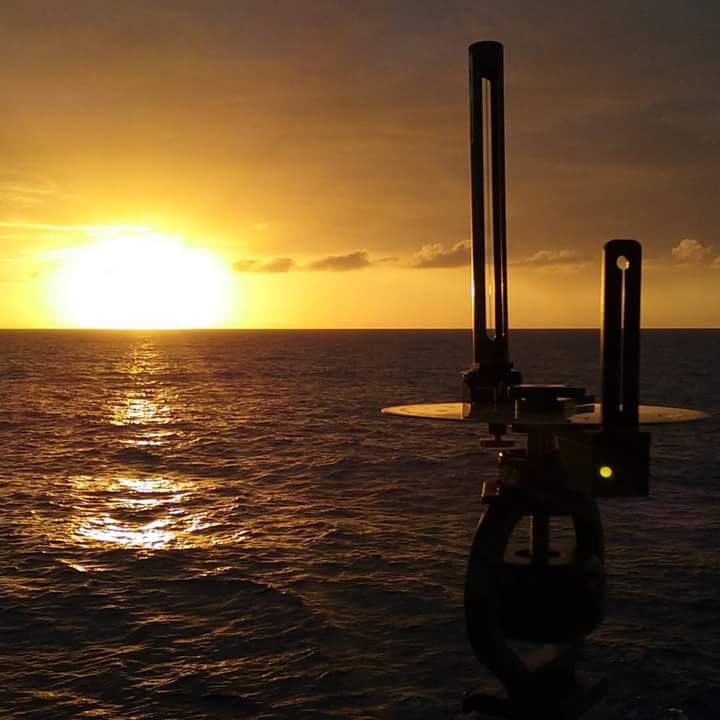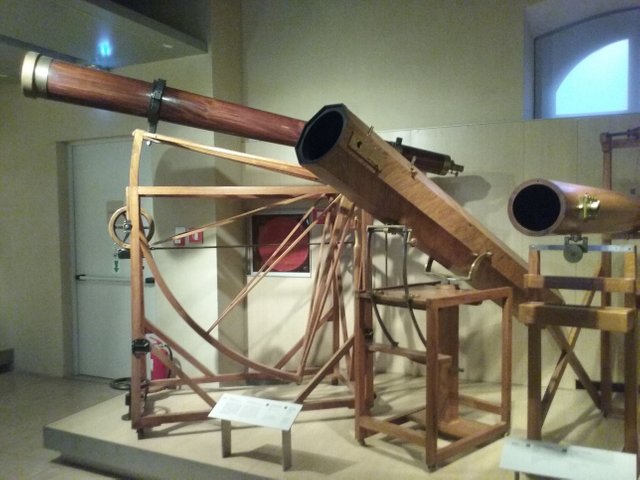Compass error by Amplitude
Compass error by Amplitude
A complete guide on how to check magnetic and compass error at sea.
Error by amplitude is only one of a few methods of determining compass error on the high seas, but though it is simple, it can only be done when the sun is on the celestial horizon, meaning only at sunrise or sunset.

A pelorus mounted on a gyro repeater is used in order to obtain a bearing to the sun.
| Abbreviation | Description |
|---|---|
| ZT | Zone time of observation. Note: if chronometer time is read instead of Zone Time, no ZD correction is necessary. |
| CT | If using CT instead of ZT, and CE is present, account for it. |
| (+W/-E) ZD | Zone description. If in western longitude, add ZD to ZT for GMT. If in eastern longitude, subtract ZD from ZT for GMT. |
| GMT | Greenwich Mean Time: Sum of ZT and ZD, or CT and CE. Used for finding Dec in NA. |
| Dec | Declination: found in daily pages of NA for whole hour value of GMT |
| +/- d corr ( ) | Correction for additional minutes. Note the "d" value at the bottom of the column, place value in ( ) and turn to Increments and Corrections (yellow pages) in the back of the NA. For the correct minutes, find the correction for the corresponding "d" value. |
| Dec | Sum of initial Dec and "d" correction |
| Example | sin A= (sin Dec/cos Lat) ex. Sin A= (sin 22.1/cos 36.4) |
| --> | Sin A= 0.467 |
| --> | A =W 27.867 N |
| --> | A = W 24° S |
| --> | Zn = 246° |
| --> | (270-24) |
| --> | A = E 13° N |
| --> | Zn = 77° |
| --> | (90-13) |
| --> | A = E 56° S |
| --> | Zn = 146° |
| --> | (90+56) |
| --> | A = W 30° N |
| --> | Zn = 300° |
| --> | (270+30) |
| T | True compass bearing: the Zn value we found in prior steps |
| V | Variation locally: Found on charts or is given in problems. |
| M | Magnetic bearing: Sum of T and V. Is NOT the value found by PSC. |
| D | Deviation: Compass error based on heading and magnetic field of ship itself. |
| C | Compass Bearing: This is the bearing you found when you observed the body originally. |
| aW | Not a value, merely a reminder that you add West and subtract E error as you work down this form. |
Note: The difference between the T and C values is your total Compass Error.

Lets get started
- Step 1: Observe the sun's bearing on the celestial horizon, noting time of observation. This is best accomplished with an azimuth circle, Pelorus or telescopic alidade for smaller bodies.
- Step 2: Find time in GMT , either converting from CT or ZT.
- Step 3: Find Declination, make sure to note whether South or North and the trend in values, i.e. if the values are increasing, the d correction is to be added; if the values are decreasing, the d correction is to be subtracted.
Step 4:Convert Latitude and Declination from minutes and seconds into minutes and tenths of minutes. The easiest way to accomplish this is to use your calculator and divide the minutes by 60 and add the whole degrees. (ex. For 28-06 N, 6/60=0.1, 28+0.1= 28.1 N.)
Step 5: Find Amplitude (A) by using the equation sin A= (sin Dec/cos Lat). By converting to minutes and tenths above, we made it easier to enter these values into your calculator.
Step 6: Finding Zn from A.
Your calculator will simply spit out a number when you press enter, but as you notice at right, that number is now preceded by a W and succeeded by an N. Where did those come from? The W designates that the body observed is in the western sky; it is setting. You know this by one of two methods, either by noting the time at which the solar observation was made, though be careful using this method as not all bodies rise in the morning and set at night, such as the moon. The second method is simply to note the bearing of the observation. Bearings between 0 and 180 are designated as Easterly. Bearings between 180 and 360 are designated as Westerly.
The N is simply the designation of Declination. i.e. If the Dec is N, the A is designated N.
What do these values indicate? They indicate which direction the Amplitude is to be applied to find Zn. An A value of W 16 N can be read as 16° North of West, and is equivalent to a Zn of 286°.Step 7: Solve for Compass Error
Using either TVMDC or GET, solve for compass error or deviation, and you're done. TVMDC is for correction magnetic compasses, GET is for gyros. GET stands for Gyro + East error = True, if you know two parts, you can find the third.
An easy way to decide weather you have to add or subtract from 90 degrees for sunrise or add or subtract from 270 degrees from sunset is to think of a few steps :
- What hemisphere am I in?
- what season am I in ( Winter or Summer to keep it simple)
- In Southern Hemisphere, the sun sets to the Southern hemisphere when facing east for a sunrise : Therefore we add to 90
- In Southern Hemisphere, The sun sets to the Northern hemisphere when facing east for a sunrise : Therefore we subtract from 90
The same applies for Northern Hemisphere solves.
Special thanks to Deckskills.com for some of the content
Thank you to Bluewater academy for the class time and lecturers there teaching us these methods.
I Hope everyone enjoyed today's How To guide by The Yacht Guy :)
Useful links
Keep Steeming
The Yacht Guy
Great informative post! I love this stuff :)
Hey man,
Thank you!, I will do a couple more on this subject at some point :)